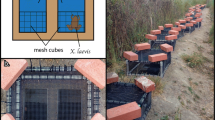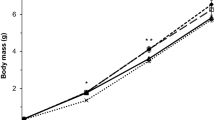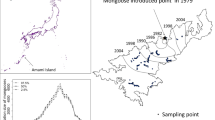Abstract
Predators impact prey in direct (lethal) and indirect (non-lethal) manners. Predator-avoidance models capitalize on the non-lethal effects of predators to study how predator-induced fear impacts prey behavior and physiology. Here, we aimed to develop a predator avoidance model to determine how predators alter feeding and anxiety-like behavior in the African clawed frog (Xenopus laevis). We determined (1) the repeatability of frog behavior over time, (2) the effect of a stimulus (nothing, a size-matched or a large conspecific [potential predator]) on frog behavior, and (3) the effect of a stimulus on frog behavior in the presence of food. Twelve juvenile experimental frogs were exposed to all three stimulus conditions over 1 week. We predicted that (1) frog baseline behavior would be repeatable, and that (2) the presence of the large frog, but not size-matched frog, would increase fear and anxiety-like behaviors (hiding and inactivity) and would decrease food consumption and the number of air gulps. In the presence of both food and stimulus, experimental frogs ate significantly less when exposed to a large (potential predator) vs. a size-matched and no frog and took more time to first contact the food. Time spent inactive and number of air gulps did not differ across conditions. Few frogs hid during the behavioral trials. Time spent exploring and inactive and tank locations were repeatable over time. Overall, our paradigm is a viable model for studying the effects of predators on prey behavior, especially as it relates to feeding.
Significance statement
Predators can induce fear and anxiety in prey and can alter prey behavior. We sought to develop a predator-avoidance model to study prey anxiety and feeding behavior in African clawed frogs. We determined (1) the repeatability of baseline behavior over time, (2) the effect of a stimulus (no, a size-matched, or a large [predatory] frog) on frog behavior, and (3) the effect of a stimulus on behavior in the presence of food. The presence of a potential predator alone did not significantly alter prey behavior. With predator + food, experimental frogs took longer to contact food, ate less, and spent less time feeding. Most activity and location behaviors were repeatable over time. This paradigm is a viable model for studying the effects of predators on prey feeding behavior.


Similar content being viewed by others
References
Abrams P, Ginzburg L (2000) The nature of predation: prey dependent, ratio dependent or neither? Trends Ecol Evol 15:337–341
Abramsky Z, Rosenzweig M, Subach A (2002) The costs of apprehensive foraging. Ecology 83:1330–1340
Abreu MS, Giacomini ACVV, Kalueff AV, Barcellos LJG (2016) The smell of “anxiety”: behavioral modulation by experimental anosmia in zebrafish. Physiol Behav 157:67–71
Adamec R (1997) Transmitter systems involved in neural plasticity underlying increased anxiety and defense—implications for understanding anxiety following traumatic stress. Neurosci Biobehav Rev 21:755–765
Adamec R, Head D, Blundell J, Burton P, Berton O (2006) Lasting anxiogenic effects of feline predator stress in mice: sex differences in vulnerability to stress and predicting severity of anxiogenic response from the stress experience. Physiol Behav 88:12–29
Adamec R, Muir C, Grimes M, Pearcey K (2007) Involvement of noradrenergic and corticoid receptors in the consolidation of the lasting anxiogenic effects of predator stress. Behav Brain Res 179:192–207
Ahmed O, Seguin D, Gerlai R (2011) An automated predator avoidance task in zebrafish. Behav Brain Res 216:166–171
Bass SL, Gerlai R (2008) Zebrafish (Danio rerio) responds differentially to stimulus fish: the effects of sympatric and allopatric predators and harmless fish. Behav Brain Res 186:107–117
Bell AM, Hankison SJ, Laskowski KL (2009) The repeatability of behaviour: a meta-analysis. Anim Behav 77:771–783
Bramley GN, Waas JR, Henderson HV (2000) Responses of wild Norway rats (Rattus norvegicus) to predator odors. J Chem Ecol 26:705–719
Caldwell G (1986) Predation as a selective force on foraging herons: effects of plumage color and flocking. Auk 103:494–505
Carr JA (2015) I’ll take the low road: the evolutionary underpinnings of visually triggered fear. Front Neurosci 9:414
Chum H, Felt S, Garner J, Green S (2013) Biology, behavior, and environmental enrichment for the captive African clawed frog (Xenopus spp. Appl Anim Behav Sci 143:150–156
Clarke J (1983) Moonlight’s influence on predator/prey interactions between short-eared owls (Asio flammeus) and deermice (Peromyscus maniculatus. Behav Ecol Sociobiol 13:205–209
Clinchy M, Zanette L, Boonstra R, Wingfield JC, Smith JN (2004) Balancing food and predator pressure induces chronic stress in songbirds. Proc R Soc Lond B 271:2473–2479
Clinchy M, Schulkin J, Zanette L, Sheriff MJ, McGowan PO, Boonstra R (2011) The neurological ecology of fear: insights neuroscientists and ecologists have to offer one another. Front Behav Neurosci 5:21
Clinchy M, Sheriff M, Zanette L (2013) Predator-induced stress and the ecology of fear. Funct Ecol 27:56–65
Cohen H, Zohar J (2004) An animal model of posttraumatic stress disorder: the use of cut-off behavioral criteria. Ann N Y Acad Sci 1032:167–178
Cohen H, Zohar J, Matar M (2003) The relevance of differential response to trauma in an animal model of posttraumatic stress disorder. Biol Psychiat 53:463–473
Crespi EJ, Unkefer MK (2014) Development of food intake controls: neuroendocrine and environmental regulation of food intake during early life. Horm Behav 66:74–85
Dunlap KD, Tran A, Ragazzi MA, Krahe R, Salazar VL (2016) Predators inhibit brain cell proliferation in natural populations of electric fish, Brachyhypopomus occidentalis. Proc R Soc B 283:20152113
Fenn M, Macdonald D (1995) Use of middens by red foxes: risk reverses rhythms of rats. J Mammal 76:130–136
Gerlai R, Fernandes Y, Pereira T (2009) Zebrafish (Danio rerio) responds to the animated image of a predator: towards the development of an automated aversive task. Behav Brain Res 201:318–324
Harris BN, Carr JA (2016) The role of the hypothalamus-pituitary-adrenal/interrenal axis in mediating predator-avoidance trade-offs. Gen Comp Endocrinol 230-231:110–142
Hawlena D, Schmitz OJ (2010) Physiological stress as a fundamental mechanism linking predation to ecosystem functioning. Am Nat 176:537–556
Helfman GS (1989) Threat-sensitive predator avoidance in damselfish-trumpetfish interactions. Behav Ecol Sociobiol 24:47–58
Herman JP, Figueiredo H, Nancy MK, Ulrich-Lai Y, Ostrander MM, Choi DC, Cullinan WE (2003) Central mechanisms of stress integration: hierarchical circuitry controlling hypothalamo-pituitary-adrenocortical responsiveness. Front Neuroendocrinol 24:151–180
Kalueff AV, Wheaton M, Murphy DL (2007) What’s wrong with my mouse model?: advances and strategies in animal modeling of anxiety and depression. Behav Brain Res 179:1–18
Kavaliers M, Choleris E (2001) Antipredator responses and defensive behavior: ecological and ethological approaches for the neurosciences. Neurosci Biobehav Rev 25:577–586
Khor YM, Soga T, Parhar IS (2013) Caffeine neuroprotects against dexamethasone-induced anxiety-like behaviour in the zebrafish (Danio rerio. Gen Comp Endocrinol 181:310–315
Kotler BP (1984) Risk of predation and the structure of desert rodent communities. Ecology 65:689–701
Krebs C, Boutin S, Boonstra R, Sinclair ARE, Smith JNM, Dale MRT, Martin K, Turkington R (1995) Impact of food and predation on the snowshoe hare cycle. Science 269:1112–1115
Lessells CM, Boag PT (1987) Unrepeatable repeatabilities: a common mistake. Auk 104:116–121
Lima S (1998) Nonlethal effects in the ecology of predator-prey interactions. Bioscience 48:25–34
Loonen AJ, Ivanova SA (2015) Circuits regulating pleasure and happiness: the evolution of reward-seeking and misery-fleeing behavioral mechanisms in vertebrates. Front Neurosci 9:394
Luca RM, Gerlai R (2012) In search of optimal fear inducing stimuli: differential behavioral responses to computer animated images in zebrafish. Behav Brain Res 226:66–76
Magani F, Luppi T, Nuñez J, Tomsic D (2016) Predation risk modifies behaviour by shaping the response of identified brain neurons. J Exp Biol 219:1172–1177
Matsuda K, Kang KS, Sakashita A, Yahashi S, Vaudry H (2011) Behavioral effect of neuropeptides related to feeding regulation in fish. Ann N Y Acad Sci 1220:117–126
Matsuda K, Hagiwara Y, Shibata H, Sakashita A, Wada K (2013) Ovine corticotropin-releasing hormone (oCRH) exerts an anxiogenic-like action in the goldfish, Carassius auratus. Gen Comp Endocrinol 188:118–122
Maximino C, de Brito TM, de Mattos Dias CAG, Gouveia A, Morato S (2010) Scototaxis as anxiety-like behavior in fish. Nat Protoc 5:209–216
McGregor IS, Dielenberg RA (1999) Differential anxiolytic efficacy of a benzodiazepine on first versus second exposure to a predatory odor in rats. Psychopharmacol 147:174–181
McNamara J, Houston A (1986) The common currency for behavioral decisions. Am Nat 127:358–378
Monaghan P (2008) Early growth conditions, phenotypic development and environmental change. Philos T Roy Soc B 363:1635–1645
Monclús R, Rödel HG, von Holst D, De Miguel J (2005) Behavioural and physiological responses of naive European rabbits to predator odour. Anim Behav 70:753–761
Nieuwkoop PD, Faber J (1994) External and internal stage criteria in the development of Xenopus laevis. In: Nieuwkoop PD, Faber J (eds) Normal table of Xenopus laevis (Daudin): a systematical and chronological survey of the development from the fertilized egg till the end of metamorphosis, 3rd edn. Routledge, New York, pp. 162–188
Peckarsky B, Cowan C, Penton M, Anderson C (1993) Sublethal consequences of stream-dwelling predatory stoneflies on mayfly growth and fecundity. Ecology 74:1836–1846
Preisser E, Bolnick DI, Bernard MF (2005) Scared to death? The effects of intimidation and consumption in predator-prey interactions. Ecology 86:501–509
Putman BJ, Coss RG, Clark RW (2015) The ontogeny of antipredator behavior: age differences in California ground squirrels (Otospermophilus beecheyi) at multiple stages of rattlesnake encounters. Behav Ecol Sociobiol 69:1447–1457
Ripple W, Beschta R (2004) Wolves and the ecology of fear: can predation risk structure ecosystems? Bioscience 54:755–766
Schmitz O, Beckerman A, O’Brien K (1997) Behaviorally mediated trophic cascades: effects of predation risk on food web interactions. Ecology 78:1388–1399
Sibly R, Calow P (2009) A life-cycle theory of responses to stress. Biol J Linn Soc 37:101–116
Sih A (1986) Antipredator responses and the perception of danger by mosquito larvae. Ecology 67:434–441
Sih A (1992) Prey uncertainty and the balancing of antipredator and feeding needs. Am Nat 139:1052–1069
Skilleter G, Peterson C (1994) Control of foraging behavior of individuals within an ecosystem context: the clam Macoma balthica and interactions between competition and siphon cropping. Oecologia 100:268–278
Stewart AM, Kalueff AV (2014) Anxiolytic drug discovery: what are the novel approaches and how can we improve them? Expert Opin Drug Discov 9:15–26
Stewart AM, Braubach O, Spitsbergen J, Gerlai R, Kalueff AV (2014) Zebrafish models for translational neuroscience research: from tank to bedside. Trends Neurosci 37:264–278
Suraci JP, Clinchy M, Dill LM, Roberts D, Zanette LY (2016) Fear of large carnivores causes a trophic cascade. Nat Commun 7:1–7
Tinsley RC, Kobel HR (1996) The biology of Xenopus. Clarendon Press, Oxford
Valeix M, Fritz H, Loveridge A, Davidson Z, Hunt JE, Murindagomo F, Macdonald DW (2009) Does the risk of encountering lions influence African herbivore behaviour at waterholes? Behav Ecol Sociobiol 63:1483–1494
Werner EE, Gilliam JF, Hall DJ, Mittelbach GG (1983) An experimental test of the effects of predation risk on habitat use in fish. Ecology 64:1540–1548
Wirsing A, Heithaus M, Dill L (2007) Living on the edge: dugongs prefer to forage in microhabitats that allow escape from rather than avoidance of predators. Anim Behav 74:93–101
Wolak ME, Fairbairn DJ, Paulsen YR (2012) Guidelines for estimating repeatability. Methods Ecol Evol 3:129–137
Zanette L, Smith JN, van Oort H, Clinchy M (2003) Synergistic effects of food and predators on annual reproductive success in song sparrows. Proc R Soc Lond B 270:799–803
Zoladz PR, Conrad CD, Fleshner M, Diamond DM (2008) Acute episodes of predator exposure in conjunction with chronic social instability as an animal model of post-traumatic stress disorder. Stress 11:259–281
Acknowledgments
We would like to thank the Texas Tech University Honor’s College and Center for the Integration of Science, Technology, Engineering and Math Education and Research (CISER) for their support to P.D., and the Texas Tech University Center for Active Learning and Undergraduate Engagement (CALUE), the Department of Biological Sciences, and the Texas Tech University Association of Biologists for helping to fund this work. We also thank two anonymous reviewers for their thoughtful and helpful comments on a previous draft of this manuscript.
Author information
Authors and Affiliations
Corresponding author
Ethics declarations
Funding
This study was funded by a Texas Tech University (TTU) Center for Active Learning and Undergraduate Engagement (CALUE) grant to PED, a TTU Association of Biologists grant to CP, and by the TTU Department of Biological Sciences initial funds to BNH.
Conflict of interest
The authors declare that they have no conflict of interest.
Ethical approval
All applicable international, national, and/or institutional guidelines for the care and use of animals were followed. All procedures followed the Guide for the Care and Use of Laboratory Animals and were reviewed and approved by the IACUC of Texas Tech University. This article does not contain any studies with human participants performed by any of the authors.
Additional information
Communicated by K. Summers
Rights and permissions
About this article
Cite this article
Duggan, P.E., Prater, C., Carr, J.A. et al. Predator presence decreases food consumption in juvenile Xenopus laevis . Behav Ecol Sociobiol 70, 2005–2015 (2016). https://doi.org/10.1007/s00265-016-2204-1
Received:
Revised:
Accepted:
Published:
Issue Date:
DOI: https://doi.org/10.1007/s00265-016-2204-1




